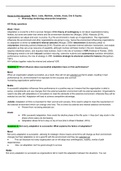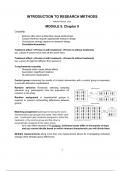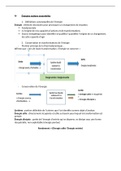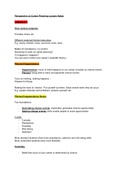Summary
Lecture 1: Introduction
• Gulati, R. (1998). Alliances and networks. Strategic Management Journal, 19(4), 293-317.
• Tsang, E. (2000). Transaction cost and resource-based explanations of joint ventures: A Com-
parison and synthesis. Organization Studies, 21(1), 215-242. (Not complete)
Lecture 2: Cooperation types and partner types
• Gassmann, O., Zeschky, M., Wolff, T., Stahl, M. (2010). Crossing the industry-line: Break-
through innovation through cross-industry alliances with ‘non-suppliers’. Long Range Planning,
43(5-6), 639-654.
• Wuyts, S., Dutta, S. (2014). Benefiting from Alliance Portfolio Diversity: The Role of Past Internal
Knowledge Creation Strategy. Journal of Management, 40(6), 1653-1674.
• Asgari, N., Tandon, V., Singh, K., & Mitchell, W. (2018). Creating and taming discord: How firms
manage embedded competition in alliance portfolios to limit alliance termination. Strategic Man-
agement Journal, 39(12), 3273-3299.
• Hannah, D. P., & Eisenhardt, K. M. (2018). How firms navigate cooperation and competition in
nascent ecosystems. Strategic Management Journal, 39(12), 3163-3192.
Lecture 3: Alliance governance
• De Man, A. P., Roijakkers, N. (2009). Alliance governance: Balancing control and trust in dealing
with risk. Long Range Planning, 42(1), 75-95.
• Oxley, J. E., & Sampson, R. C. (2004). The scope and governance of international R&D alli-
ances. Strategic Management Journal, 25(8-9), 723–749.
• Reuer, J. J., & Devarakonda, S. V. (2016). Mechanisms of Hybrid Governance: Administrative
Committees in Non-Equity Alliances. Academy of Management Journal, 59(2), 510–533.
• Devarakonda, S. V., & Reuer, J. J. 2019. Safeguarding from the Sharks: Board Representation
in Minority Equity Partnerships. Organization Science, 30(5): 981–999.
Lecture 4: Management of cooperative innovation activities
• Heimeriks, K. H., Klijn, E., Reuer, J. J. (2009). Building capabilities for alliance portfolios. Long
Range Planning, 42(1), 96-114.
• Du, J., Leten, B., Vanhaverbeke, W. (2014). Managing open innovation projects with science-
based and market-based partners. Research Policy, 43(5), 828-840.
• Rouyre, A., & Fernandez, A. S. (2019). Managing knowledge sharing-protecting tensions in
coupled innovation projects among several competitors. California Management Review, 62(1),
95-120.
• Kapoor, R., & Lee, J. M. (2013). Coordinating and competing in ecosystems: How organizational
forms shape new technology investments. Strategic Management Journal, 34(3), 274-296.
Lecture 5: Capturing value from cooperation
• Wadhwa, A., Bodas Freitas, I., Sarker, M.B. (2017). The paradox of openness and value pro-
tection strategies: Effect of extramural R&D on innovative performance. Organization Science,
28, 873–893.
• Laursen, K., Salter, A. (2014). The paradox of openness: Appropriability, external search and
collaboration. Research Policy, 43, 867–878.
• Katila R., Rosenberger J.D., Eisenhardt K.M. (2008). Swimming with sharks: Technology ven-
tures, defense mechanisms and corporate relationships. Administrative Science Quarterly,
53(2), 295-332.
• Prashantham, S., & Birkinshaw, J. (2008). Dancing with gorillas: How small companies can
partner effectively with MNCs. California Management Review, 51(1), 6-23.
,Lecture 6: Cooperation and performance
• Lahiri, N., Narayanan, S. (2013). Vertical integration, innovation, and alliance portfolio size: Im-
plications for firm performance. Strategic Management Journal, 34, 1042-1064.
• Sampson, R. (2007). R&D alliances and firm performance: The impact of technological diversity
and alliance organization on innovation. Academy of Management Journal, 50(2), 364-386.
• Hoehn-Weiss, M., Karim, S., Lee, C-H. (2017). Examining alliance portfolios beyond the dyads:
The relevance of redundancy and nonuniformity across and between partners. Organization
Science, 28(1), 56-73.
• Kumar, R. (2014). Managing ambiguity in strategic alliances. California Management Review,
56(4), 82-102.
,Lecture 1: Introduction
Gulati, R. (1998). Alliances and networks. Strategic Management Journal, 19(4), 293-317.
This paper introduces a social network perspective to the study of strategic alliances. It extends prior
research, which has primarily considered alliances as dyadic exchanges and paid less attention to the
fact that key precursors, processes, and outcomes associated with alliances can be defined and shaped
in important ways by the social networks within which most firms are embedded. It identifies five key
issues for the study of alliances: (1) the formation of alliances, (2) the choice of governance structure,
(3) the dynamic evolution of alliances, (4) the performance of alliances, and (5) the performance conse-
quences for firms entering alliances. For each of these issues, this paper outlines some of the current
research and debates at the firm and dyad level and then discusses some of the new and important
insights that result from introducing a network perspective. It highlights current network research on
alliances and suggests an agenda for future research.
Introduction
I define strategic alliances as voluntary arrangements between firms involving exchange, sharing, or co-
development of products, technologies, or services. They can occur because of a wide range of motives
and goals, take a variety of forms, and occur across vertical and horizontal boundaries.
From a strategic standpoint, some of the key facets of the behavior of firms as it relates to alliances can
be understood by looking at the sequence of events in alliances. This sequencing includes the decision
to enter an alliance, the choice of an appropriate partner, the choice of structure for the alliance, and the
dynamic evolution of the alliance as the relationship develops over time.
(1) Which firms enter alliances and whom do they choose as partners?
(2) What types of contracts do firms use to formalize the alliance? and
(3) How do the alliance and the partners’ participation evolve over time?
A second important issue for alliances is their performance consequences, both in terms of the perfor-
mance of the alliance relationship itself and the performance of firms entering alliances.
(1) What factors influence the success of alliances? and
(2) What is the effect of alliances on the performance of firms entering them?
Social Structure and the Embeddedness of Firm Behavior
A social network can be defined as ‘a set of nodes (e.g., persons, organizations) linked by a set of social
relationships (e.g., friendship, transfer of funds, overlapping membership) of a specified type.’ Network
perspectives build on the general notion that economic actions are influenced by the social context in
which they are embedded and that actions can be influenced by the position of actors in social networks.
Embeddedness refers to the fact that exchanges and discussions within a group typically have a history,
and that this history results in the routinization and stabilization of linkages among members. A structure
of relations affects the actions taken by the individual actors composing it. It does so by constraining the
set of actions available to the individual actors and by changing the dispositions of those actors toward
the actions they may take.
Underlying embeddedness is the quest for information to reduce uncertainty, a quest that has been
identified as one of the main drivers of organizational action. There have been four broad foci of prior
research on the influence of social networks: inequality, embedding, contagion, and contingency.
• Research on inequality suggests how network connections can explain differences in the re-
sources available to individuals, groups, or organizations,
• Research on embedding describes the institutions and identities resulting from networks and
how they enable difficult transactions,
, • Research on contagion has shown how networks can promote behavioral conformity by serving
as conduits for both technological and social information about organizational activities, which
in turn can influence the extent to which they adopt new innovations
• Contingency approaches suggest how social networks can moderate key organizational pro-
cesses.
There are two broad analytical approaches for examining the influence of social networks. The first
emphasizes the differential informational advantages bestowed by social networks, while the second
highlights the control benefits actors can generate by being advantageously positioned within a social
network. Networks may provide informational benefits through two mechanisms:
• Relational embeddedness or cohesion perspectives on networks stress the role of direct cohe-
sive ties as a mechanism for gaining fine-grained information.
• Structural embeddedness or positional perspectives on networks go beyond the immediate ties
of firms and emphasize the informational value of the structural position these partners occupy
in the network.
Relational embeddedness typically suggests that actors who are strongly tied to each other are likely to
develop a shared understanding of the utility of certain behavior because of discussing opinions in
strong, socializing relations, which in turn influence their actions. Cohesive ties can become a unique
source of information about the partner’s capabilities and reliability. Structural embeddedness focuses
on the informational role of the position an organization occupies in the overall structure of the network.
Because an actor’s status is based on its affiliations and patterns of interaction, it is affected by its web
of affiliations and by the status of its exchange partners. When focusing on an interorganizational con-
text, we can also view status as an attribution of the quality of products an actor–organization provides
when the quality cannot be directly observed. Thus, status groupings resulting from network position
can provide powerful informational cues for actors about the likely behavior of others in the network.
An actor in a social network can derive control advantages by being the tertius gaudens, or one who is
situated between two other actors. This can occur either when two or more actors are after the same
relationship with a focal actor, as is the case when multiple firms want to enter an alliance with a given
firm or can occur when an actor is the tertius in separate relationships with two actors with conflicting
demands, as may occur for a firm that has separate alliances with two independent firms that may create
conflicting demands.
In the case of alliances, firms with more social capital will not only have access to information about a
larger number of alliances, but they may also be able to attract better partners who want to ally with
them. Furthermore, they may be able to extract superior terms of trade because of possible control
benefits that may ensue from their social capital. The informational benefits from social networks can
have ramifications for the development and ultimate success of the alliance itself. Ties that are structur-
ally embedded can have fundamentally different characteristics and life course than those that are not.
Embedded ties promote greater frequency of information exchange between partners, which can affect
the success of the alliance as well as the performance of firms entering them.
Key Issues in Alliances
The Formation of Alliances
Firms don’t form alliances as symbolic social affirmations of their social networks but, rather, base alli-
ances on concrete strategic complementarities that they have to offer each other. It does suggest that
the conditions of mutual economic advantage are necessary but not sufficient conditions for the for-
mation of an alliance between two firms. While considerations of individual quest for resources and
complementarity are relevant, it is a firm’s social connections that help it identify new alliance opportu-
nities and choose specific partners that possess such complementary assets.










